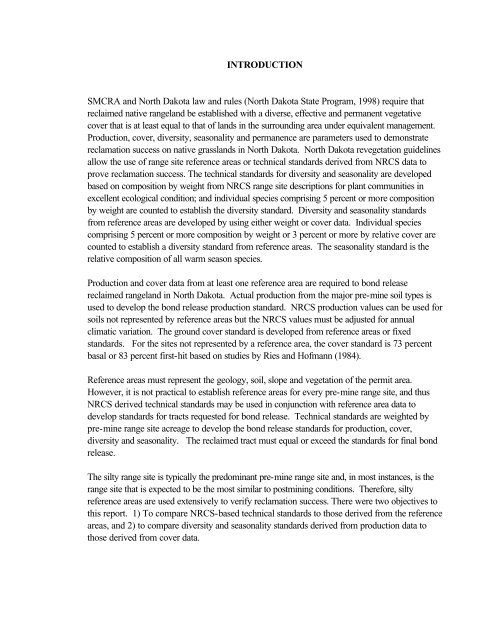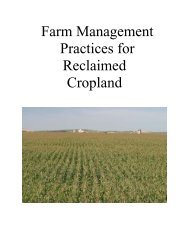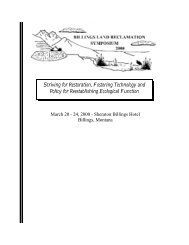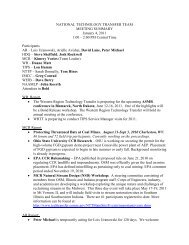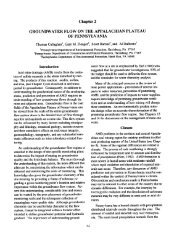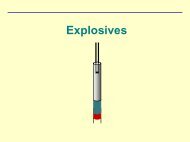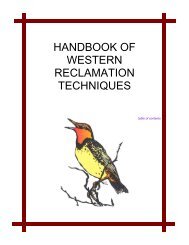Revegetation - OSM Technology Transfer - Office of Surface Mining
Revegetation - OSM Technology Transfer - Office of Surface Mining
Revegetation - OSM Technology Transfer - Office of Surface Mining
Create successful ePaper yourself
Turn your PDF publications into a flip-book with our unique Google optimized e-Paper software.
INTRODUCTION<br />
SMCRA and North Dakota law and rules (North Dakota State Program, 1998) require that<br />
reclaimed native rangeland be established with a diverse, effective and permanent vegetative<br />
cover that is at least equal to that <strong>of</strong> lands in the surrounding area under equivalent management.<br />
Production, cover, diversity, seasonality and permanence are parameters used to demonstrate<br />
reclamation success on native grasslands in North Dakota. North Dakota revegetation guidelines<br />
allow the use <strong>of</strong> range site reference areas or technical standards derived from NRCS data to<br />
prove reclamation success. The technical standards for diversity and seasonality are developed<br />
based on composition by weight from NRCS range site descriptions for plant communities in<br />
excellent ecological condition; and individual species comprising 5 percent or more composition<br />
by weight are counted to establish the diversity standard. Diversity and seasonality standards<br />
from reference areas are developed by using either weight or cover data. Individual species<br />
comprising 5 percent or more composition by weight or 3 percent or more by relative cover are<br />
counted to establish a diversity standard from reference areas. The seasonality standard is the<br />
relative composition <strong>of</strong> all warm season species.<br />
Production and cover data from at least one reference area are required to bond release<br />
reclaimed rangeland in North Dakota. Actual production from the major pre-mine soil types is<br />
used to develop the bond release production standard. NRCS production values can be used for<br />
soils not represented by reference areas but the NRCS values must be adjusted for annual<br />
climatic variation. The ground cover standard is developed from reference areas or fixed<br />
standards. For the sites not represented by a reference area, the cover standard is 73 percent<br />
basal or 83 percent first-hit based on studies by Ries and H<strong>of</strong>mann (1984).<br />
Reference areas must represent the geology, soil, slope and vegetation <strong>of</strong> the permit area.<br />
However, it is not practical to establish reference areas for every pre-mine range site, and thus<br />
NRCS derived technical standards may be used in conjunction with reference area data to<br />
develop standards for tracts requested for bond release. Technical standards are weighted by<br />
pre-mine range site acreage to develop the bond release standards for production, cover,<br />
diversity and seasonality. The reclaimed tract must equal or exceed the standards for final bond<br />
release.<br />
The silty range site is typically the predominant pre-mine range site and, in most instances, is the<br />
range site that is expected to be the most similar to postmining conditions. Therefore, silty<br />
reference areas are used extensively to verify reclamation success. There were two objectives to<br />
this report. 1) To compare NRCS-based technical standards to those derived from the reference<br />
areas, and 2) to compare diversity and seasonality standards derived from production data to<br />
those derived from cover data.


